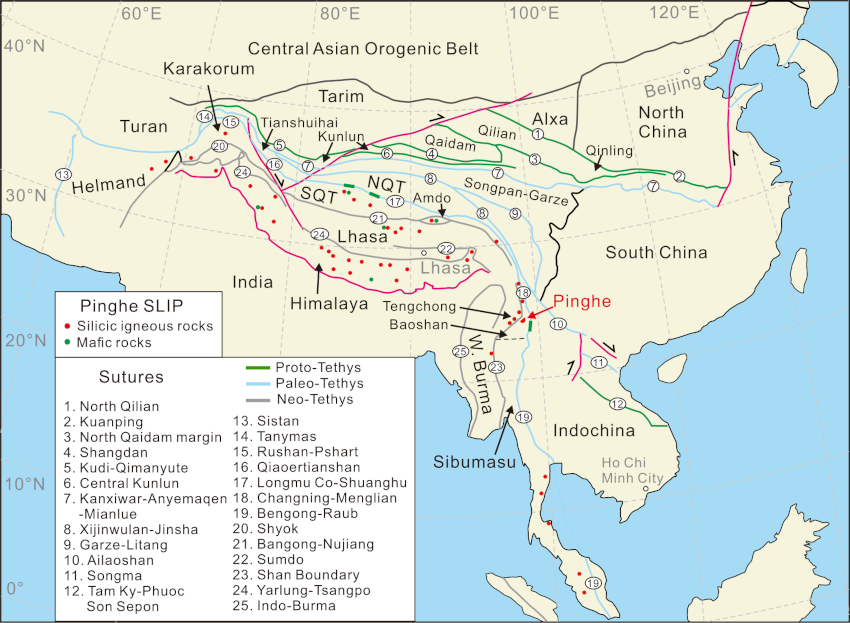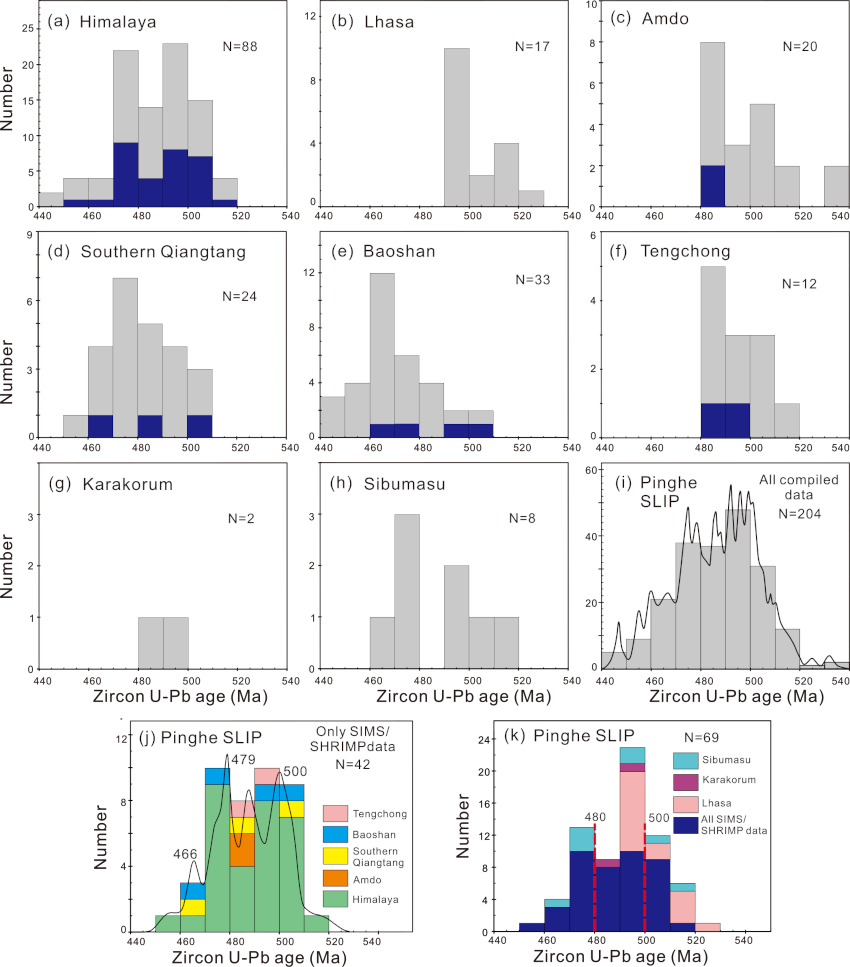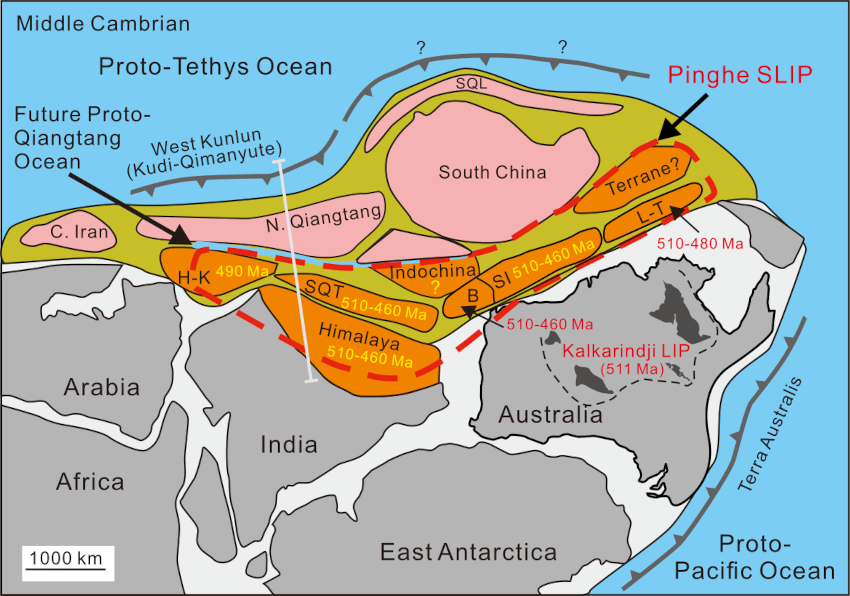November 2022 LIP of the Month
The Cambrian-Ordovician Pinghe silicic large igneous province
Wei Dan1, 2, J. Brendan Murphy3,4, Gong-Jian Tang1, 2, Xiu-Zheng Zhang1, 2, William M. White5, Qiang Wang1, 2, 6
1 State Key Laboratory of Isotope Geochemistry, Guangzhou Institute of Geochemistry, Chinese Academy of Sciences, Guangzhou 510640, China
2 CAS Center for Excellence in Deep Earth Science, Guangzhou, 510640, China
3 Department of Earth Sciences, St Francis Xavier University, PO Box 5000, Antigonish, Nova Scotia, B2G 2W5 Canada
4 Earth Dynamics Research Group, The Institute for Geoscience Research (TIGeR), School of Earth and Planetary Sciences, Curtin University, WA 6845, Australia
5 Department of Earth and Atmospheric Sciences, Cornell University, Ithaca, New York 14853, USA
6 College of Earth and Planetary Sciences, University of Chinese Academy of Sciences, Beijing 10049, China
Email: danwei@gig.ac.cn
Extracted and modified from: Dan, W., Murphy, J.B., Tang, G.J., Zhang, X.Z., White, W.M. and Wang, Q. 2022. Cambrian–Ordovician magmatic flare-up in NE Gondwana: A silicic large igneous province? Geological Society of America Bulletin, https://doi.org/10.1130/B36331.1.
Introduction
Mainland northeastern Gondwana and adjacent peri-Gondwanan terranes were affected by regionally widespread Cambrian-Ordovician tectono-magmatic events which include the emplacement of the ~511 Ma Kalkarindji large igneous province (LIP) in northern Australia (Glass and Phillips, 2006; Ware et al., 2018), the opening of the Proto-Qiangtang Ocean at ~500 Ma (Dan et al., 2022), widely distributed Cambrian-Ordovician igneous rocks (Gao et al., 2019; Liu et al., 2019), and a regional unconformity between Cambrian and Ordovician strata (Myrow et al., 2010; Liu et al., 2019). However, the tectonic setting of these Cambrian-Ordovician events, i.e., subduction-related orogenesis (Cawood et al., 2007) versus an extensional setting (Liu et al., 2019) is highly debated. In this contribution, we draw attention to abundant Cambrian-Ordovician igneous rocks in eastern Asia and adjacent regions, which were located south of the Proto-Tethys Ocean and pre-date the Silurian opening of the Paleo-Tethys Ocean (Fig. 1), and summarize the evidence that they may constitute a silicic large igneous province (SLIP).

Figure 1 Present tectonic framework for the East Asia and adjacent areas, also showing the distribution of the Pinghe SLIP. Numerous sutures depicted as Proto-Tethys (Late Proterozoic-Silurian), Paleo-Tethys (Silurian or Devonian-Later Triassic) and Neo-Tethys (Permian-Eocene) complicate the reconstruction of the Pinghe SLIP. NQT, Northern Qiangtang, SQT, Southern Qiangtang.
Definition of the Pinghe SLIP
Duration and pulses of Magmatism
A compilation of zircon U-Pb crystallization ages of Cambrian-Ordovician igneous rocks in NE Gondwana and adjacent peri-Gondwanan terranes is presented in Fig. 2. More than 200 zircon U-Pb ages (including LA-ICPMS and SIMS/SHRIMP methods) loosely constrain their crystallization ages mostly between ~520-450 Ma but with no obvious age peaks (Fig. 2i). The SIMS/SHRIMP zircon U-Pb age data, suitable for deducing the duration of a LIP ((Dan et al., 2021), more tightly constrain the crystallization ages of Cambrian-Ordovician igneous rocks to mostly between 510-460 Ma (Fig. 2j). We maintain that if the age peak is obtained from more than two terranes, this event would be widespread and can be interpreted as a major pulse. Figs. 2j-k show there are two major peaks at ~500 Ma and ~480 Ma, which are prevalent in almost each terrane, and a minor peak at ~466 Ma. We conclude the Cambrian-Ordovician magmatism was generated during 510-460 Ma, but with two major pulses of ~500 Ma and ~480 Ma.

Figure 2 Magmatic age compilation for the Pinghe SLIP. (a-h) Zircon U-Pb age for individual terrane. The light gray box and dark bule box indicate zircon U-Pb ages dated by LA-ICPMS and SIMS/SHRIMP methods, respectively. (i-k) Zircon U-Pb age for all terranes. All zircon U-Pb age dated by LA-ICPMS, SIMS/SHRIMP methods are compiled for (i), and only SIMS/SHRIMP zircon U-Pb age for (j). We combine LA-ICPMS data from Lhasa, Karakorum and Sibumasu terranes with SIMS/SHRIMP data to obtain (k). The age peaks of ~500 Ma and ~480 Ma in (k) are from (j) based on SIMS/SHRIMP data. Bin width is 10 Myr for each panel.
Size and tectonic setting of magmatism
The original distribution of the putative Pinghe SLIP has been disrupted by subsequent tectonic activity along the northern Gondwanan margin and by the >600 km of Cenozoic crustal shorting in the central Himalaya. After accounting for the effects of opening the Paleo-Tethys and Neo-Tethys oceans between peri-Gondwanan terranes, the Cambrian positions of most terranes in NE Gondwana can be reliably located (Fig. 3). The space between the Sibumasu terrane and South China in the paleogeographic reconstruction implies that there may be one unidentified terrane occupying the space between South China and Sibumasu terrane.

Figure 3 Paleogeographic reconstruction for the NE Gondwana (adapted from Yao et al. (2014); Cawood et al. (2018)). The distribution of Kalkarindji LIP is based on Ware et al. (2018). Note: The age span in each terrane is based on Figure 2 and includes all LA-ICPMS, SIMS/SHRIMP zircon ages. Using only the reliable SIMS/SHRMIP zircon ages, the Pinghe SLIP was generated mostly in two major pulses (~500 Ma and ~480 Ma). N. Qiangtang includes present day Northern Qiangtang and Tianshuihai and Songpan-Garze. The shape of the peri-Gondwanan terranes is schematic, and the scale for Gondwana and for the South China and can be used to estimate the length of the Pinghe SLIP and ~500 Ma ocean. The white line depicts the location of cross-section in Fig. 4. Terranes: B, Baoshan; C. Iran, Central Iran; H-K, Helmand-Karakorum; L-T, Lhasa-Tengchong. N. Qiangtang, Northern Qiangtang. SI, Sibumasu. SQT, Southern Qiangtang. SQL, South Qinling.
Our Cambrian paleogeographic reconstruction implies these igneous rocks were likely originally distributed in an approximately triangular region, >5000 km in length and 1000 km (greatest width), equivalent to an area of ~2.5 Mkm2, which far exceeds the minimum size (>0.1 Mkm2) criterion of a LIP. Although a precise estimate cannot be obtained from the available data, their total volume is probably huge (>2.5 Mkm3), if the average thickness of igneous rocks is ~1 km for the enclosed area (Ernst, 2014). Moreover, the Cambrian-Ordovician magmatism was far from the subduction zone, confined to south of the Proto-Qiangtang Ocean, which was opened at ~500 Ma as a backarc basin (Dan et al., 2022).
Composition
The Cambrian-Ordovician igneous rocks are predominantly silicic with minor volumes of mafic rocks (Fig. 1). The mafic rocks are enriched in light rare earth elements (LREE), depleted in high field strength elements (HFSE: Nb, Ta and Ti), and have εNd(t) values of -4.6 to +1.0, implying derivation from a lithospheric mantle previously metasomatized by components derived from a subducted slab (Miller et al., 2001; Liu et al., 2020). In contrast, the silicic igneous rocks are mostly muscovite-bearing peraluminous granites with low εNd(t) values of -11.7 to -4.9 and high zircon δ18O values of +8.1 ~ +11.4‰, suggesting they were originated by partial melting of metasedimentary rocks (Gao et al., 2019; Dan et al., 2020).
Therefore, the Cambrian-Ordovician magmatic province in NE Gondwana and peri-Gondwana terranes satisfies the criteria of defining a LIP or SLIP, here termed Pinghe SLIP. It is noteworthy that the silicic igneous rocks in this SLIP are S-type granites, in contrast to other SLIPs which are predominantly I-type or A-type igneous rocks (Bryan, 2007; Bryan and Ferrari, 2013; Ernst, 2014), suggesting the composition of silicic igneous rocks may be a less distinguishing characteristic of a SLIP than other criteria (Bryan and Ferrari, 2013).
Geodynamics of the Pinghe SLIP
We propose two possible mechanisms of asthenospheric upwelling herein (Fig. 4). One possibility is that asthenospheric upwelling was induced by a subducted slab that stagnated at mantle transition zone and underwent dehydration causing melting of the upper mantle. This model has been invoked to explain intraplate magmatism that is spatially and temporally connected to a subduction zone but is located several hundred kilometers from a continental arc and is not associated with mantle wedge melting. The model may accommodate the generation of intraplate basalts over a large area (although the volume is minor) far from a subduction zone and includes the possibility of coeval backarc extension adjacent to subduction zone. However, the mafic rocks in the Pinghe SLIP were derived from melting of metasomatized lithospheric mantle (Miller et al., 2001; Liu et al., 2020), different from oceanic island basalts (OIB) occur in this model (Xu et al., 2018). Moreover, this model does not provide a simple explanation for the large-scale melting of crust. Thus, although we don’t prefer this model, it cannot be totally excluded.

Figure 4 Proposed new geodynamic models illustrating the generation of the Pinghe SLIP. (a) Far-field subduction induced asthenospheric upwelling, (b) a mantle plume in a far-field subduction setting. The mafic rocks intruded into the lower crust and induced melting of metasedimentary rocks to generate the S-type granites in the upper crust.
Given its regional extent, the origin of Pinghe SLIP may need to be viewed in a global context. The putative Pinghe SLIP occurred after the global-scale Pan-African orogenesis, thus, magmatism of this scale may be a regional response to reorganization of deep mantle convection patterns caused by the subduction of oceanic lithosphere located in a region of downwelling between the converging continents of Gondwana (Heron et al., 2021; Murphy et al., 2021). Numerical models show this region of mantle downwelling should evolve into an upwelling, which would trigger the ascent of deep mantle plumes preferentially along Gondwana’s periphery after its assembly, as reflected in a series of circum-Gondwana plume-related magmatism in that time interval (summarized in Murphy et al. (2021)). Emplacement of a mantle plume beneath the lithosphere would explain several of the observations noted above. It would have resulted in uplift, explaining the regional Cambrian-Ordovician unconformity (Hughes et al., 2011) and ~485 Ma retrograde metamorphism in Lhasa terrane (Zhang et al., 2012). Lithospheric uplift and regional extension would have induced decompression partial melting of the lithospheric mantle, enhanced by heat provided from rising melts from the plume itself, to generate the widespread intraplate continental mafic rocks (Miller et al., 2001). Heat advected upward by these melts would in turn induce partial melting of the thickened Neoproterozoic metasedimentary rocks between Northern Qiangtang-South China and India-Australia to generate the S-type granites that dominate the Pinghe SLIP. Lateral outflow of the plume at the base of the lithosphere would induce rifting, which could have initiated opening of ocean basins (Morgan et al., 2020). A young plume arriving beneath the region provides an explanation for the nearly simultaneous opening of the Proto-Qiangtang oceanic basin (Fig. 4) and initiation of rifting of the Northern Qiangtang and South China terranes from northeast Gondwana, which are coeval with occurrence of the Pinghe SLIP.
The proposed model would be consistent with a plume origin for the adjacent ca. 511 Ma Kalkarindji LIP (Fig. 3) as proposed by Glass and Phillips (2006). Although other mechanisms may have generated the Kalkarindji LIP (Ware et al., 2018), the plume model provides a unified explanation for the coeval occurrence of the SLIP in peri-Gondwanan terranes and adjacent mafic LIP in the Australian part of Gondwana. The correlation of Pinghe SLIP with Kalkarindji LIP is analogous to the well-documented example of ~188-153 Ma Chon Aike SLIP associated with the ~183 Ma Karoo-Ferrar LIP in South America-Antarctic.
Conclusions and perspectives
An extensive belt of ~510-460 Ma granitic rocks, intruded in several pulses over a >2.5 Mkm2 area, has been recognized in the northeastern Gondwana. The granitic rocks are mostly of S-type compositions, and were intruded far from (>1000 km) from active convergent margins. This granitic province, which we infer to represent a silicic LIP (Pinghe SLIP), can be explained by the rise of a mantle plume beneath the region. The new identified Pinghe SLIP will motivate to study the link between magmatism and geologically-sudden climate-perturbations, such as extinction at the early-middle Cambrian Boundary and Top Of Cambrian Excursion (Marshall et al., 2021).
Acknowledgement
The authors greatly appreciate Prof. Ernst for encouragement and the invitation to write this article. This study was jointly supported by the National Natural Science Foundation of China (Nos. 92155306, 41872065, 91855215 and 41630208) and the Second Tibetan Plateau Scientific Expedition and Research program (STEP) (Grant No. 2019QZKK0702). JBM acknowledges the continuing funding from NSERC, Canada.
References
Bryan, S., 2007. Silicic Large Igneous Provinces. Episodes 30, 20-31.
Bryan, S.E., Ferrari, L., 2013. Large igneous provinces and silicic large igneous provinces: Progress in our understanding over the last 25 years. Geological Society of America Bulletin 125, 1053-1078.
Cawood, P.A., Johnson, M.R.W., Nemchin, A.A., 2007. Early Palaeozoic orogenesis along the Indian margin of Gondwana: Tectonic response to Gondwana assembly. Earth and Planetary Science Letters 255, 70-84.
Cawood, P.A., Zhao, G., Yao, J., Wang, W., Xu, Y., Wang, Y., 2018. Reconstructing South China in Phanerozoic and Precambrian supercontinents. Earth-Science Reviews 186, 173-194.
Dan, W., Murphy, J.B., Wang, Q., Zhang, X.Z., Tang, G.J., 2022. Tectonic evolution of the Proto-Qiangtang Ocean and its relationship with the Palaeo-Tethys and Rheic oceans, in: Hynes, A.J., Murphy, J.B. (Eds.), The Consummate Geoscientist: A Celebration of the Career of Maarten de Wit. Geological Society, London, Special Publications, pp. https://doi.org/10.1144/SP1531-2022-1146.
Dan, W., Wang, Q., Murphy, J.B., Zhang, X.-Z., Xu, Y.-G., White, W.M., Jiang, Z.-Q., Ou, Q., Hao, L.-L., Qi, Y., 2021. Short duration of Early Permian Qiangtang-Panjal large igneous province: Implications for origin of the Neo-Tethys Ocean. Earth and Planetary Science Letters 568, 117054.
Dan, W., Wang, Q., Zhang, X.Z., Tang, G.J., 2020. Early Paleozoic S-type granites as the basement of Southern Qiantang Terrane, Tibet. Lithos 356, 105395.
Ernst, R.E., 2014. Large Igneous Provinces. Cambridge University Press.
Gao, L.-E., Zeng, L., Hu, G., Wang, Y., Wang, Q., Guo, C., Hou, K., 2019. Early Paleozoic magmatism along the northern margin of East Gondwana. Lithos 334-335, 25-41.
Glass, L.M., Phillips, D., 2006. The Kalkarindji continental flood basalt province: A new Cambrian large igneous province in Australia with possible links to faunal extinctions. Geology 34, 461-464.
Heron, P., Murphy, J.B., Nance, R.D., Pysklywec, R.N., 2021. Pannotia's mantle signature: the quest for supercontinent identification, in: Murphy, J.B., Strachan, R.A., Quesada, C. (Eds.), Pannotia to Pangaea: Neoproterozoic and Paleozoic Orogenic Cycles in the Circum-Atlantic Region. Geological Society, London, Special Publications, pp. 41-61.
Hughes, N.C., Myrow, P.M., McKenzie, N.R., Harper, D.A.T., Bhargava, O.N., Tangri, S.K., Ghalley, K.S., Fanning, C.M., 2011. Cambrian rocks and faunas of the Wachi La, Black Mountains, Bhutan. Geological Magazine 148, 351-379.
Liu, Y.M., Li, S.Z., Santosh, M., Cao, H.H., Yu, S.Y., Wang, Y.H., Guo, R.H., Xu, L.S., Zhou, J., Zhou, Z.Z., 2020. The passive margin of northern Gondwana during Early Paleozoic: Evidence from the central Tibet Plateau. Gondwana Research 78, 126-140.
Liu, Y.M., Xie, C.M., Li, C., Li, S.Z., Santosh, M., Wang, M., Fan, J.J., 2019. Breakup of the northern margin of Gondwana through lithospheric delamination: Evidence from the Tibetan Plateau. Geological Society of America Bulletin 131, 675-694.
Marshall, P.E., Faggetter, L.E., Widdowson, M., 2021. Was the Kalkarindji Continental Flood Basalt Province a Driver of Environmental Change at the Dawn of the Phanerozoic?, in: Ernst, R.E., Dickson, A.J., Bekker, A. (Eds.), Large Igneous Provinces: A Driver of Global Environmental and Biotic Changes. Geophysical Monograph, pp. 435-447.
Miller, C., Thoni, M., Frank, W., Grasemann, B., Klotzli, U., Guntli, P., Draganits, E., 2001. The early Palaeozoic magmatic event in the Northwest Himalaya, India: source, tectonic setting and age of emplacement. Geological Magazine 138, 237-251.
Morgan, J.P., Taramon, J.M., Araujo, M., Hasenclever, J., Perez-Gussinye, M., 2020. Y Causes and consequences of asymmetric lateral plume flow during South Atlantic rifting. Proceedings of the National Academy of Sciences of the United States of America 117, 27877-27883.
Murphy, J.B., Nance, R.D., Cawood, P.A., Collins, W.J., Dan, W., Doucet, S., Heron, P.J., Li, Z.-X., Mitchell, R.N., Pisarevsky, S., Pufahl, P.K., Quesada, C., Spencer, C.J., Strachan, R.A., Wu, L., 2021. Pannotia: In defence of its existence and geodynamic significance, in: Murphy, J.B., Strachan, R.A., Quesada, C. (Eds.), Pannotia to Pangaea: Neoproterozoic and Paleozoic Orogenic Cycles in the Circum-Atlantic Region. Geological Society, London, Special Publications, pp. 13-39.
Myrow, P.M., Hughes, N.C., Goodge, J.W., Fanning, C.M., Williams, I.S., Peng, S., Bhargava, O.N., Parcha, S.K., Pogue, K.R., 2010. Extraordinary transport and mixing of sediment across Himalayan central Gondwana during the Cambrian-Ordovician. Geological Society of America Bulletin 122, 1660-1670.
Ware, B.D., Jourdan, F., Merle, R., Chiaradia, M., Hodges, K., 2018. The Kalkarindji Large Igneous Province, Australia: Petrogenesis of the Oldest and Most Compositionally Homogenous Province of the Phanerozoic. Journal of Petrology 59, 635-665.
Xu, Y.G., Li, H.Y., Hong, L.B., Ma, L., Ma, Q., Sun, M.D., 2018. Generation of Cenozoic intraplate basalts in the big mantle wedge under eastern Asia. Science China-Earth Sciences 61, 869-886.
Yao, W.H., Li, Z.X., Li, W.X., Li, X.H., Yang, J.H., 2014. From Rodinia to Gondwanaland: A tale of detrital zircon provenance analyses from the southern Nanhua Basin, South China. American Journal of Science 314, 278-313.
Zhang, Z., Dong, X., Liu, F., Lin, Y., Yan, R., He, Z., Santosh, M., 2012. The making of Gondwana: Discovery of 650Ma HP granulites from the North Lhasa, Tibet. Precambrian Research 212-213, 107-116.
